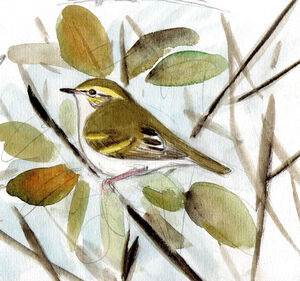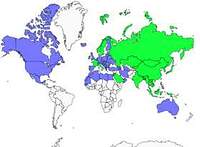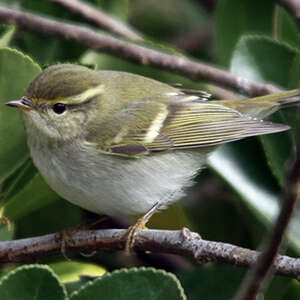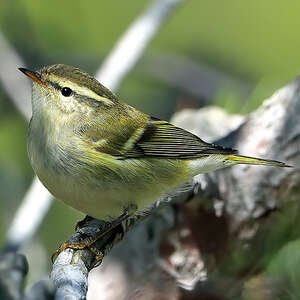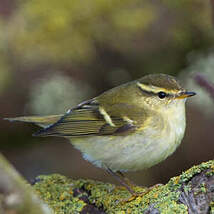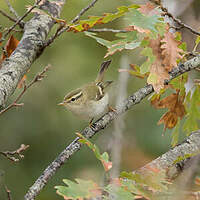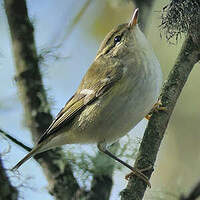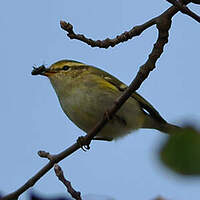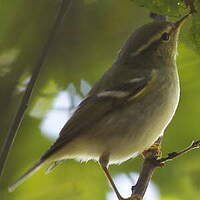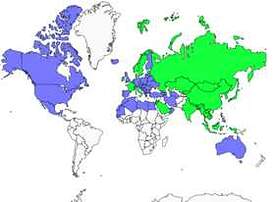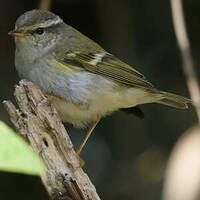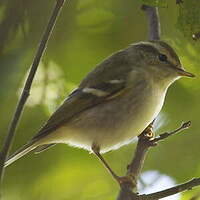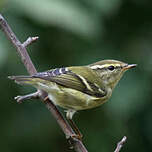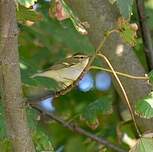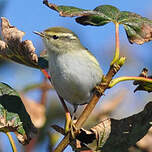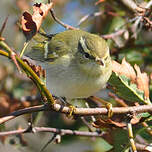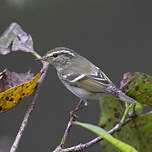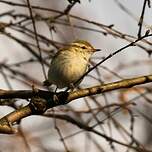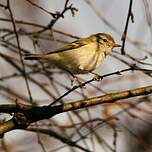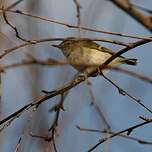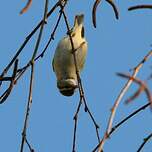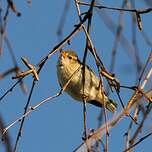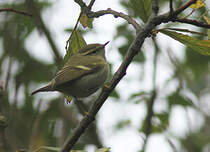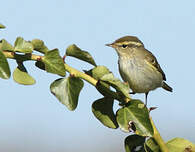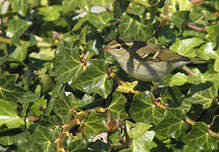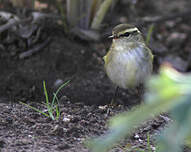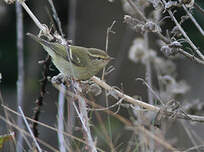Yellow-browed Warbler
Phylloscopus inornatus - Pouillot à grands sourcils
Identification
The Yellow-browed Warbler (YBW), also known as the Pouillot à grands sourcils (PGS) in French, is a small Eastern bird. Its upperparts are distinctly tinged with green while its underparts are very pale, light grey in colour. It is distinguished by three characteristics. Moreover, it is relatively small in size. It also displays a prominent, yellow and/or pale white supercilium that stretches distinctively from the bill to the neck which stands well against its dark brown-green crown and lores. Secondly, two well-defined wing bars, formed by the medium and larger coverts and finished with white or pale yellow fringe, form a dark patch in the centre of the greater coverts. The dark bases of the primary feathers increase the contrast of the second bar. Moreover, all of the remiges are paler at the edges. This effect is especially visible in the tertials. Overall, the upperwing of the YBW is very striking. Finally, in good lighting, the crown is a dark-green-brown colour and is typically and slightly paler in the centre. In addition, its rump is not jarring, its small and fine bill appears dark despite the yellow base of the lower mandible, and its tarses are brownish with yellowish toes.
Subspecific information monotypic species
Foreign names
- Pouillot à grands sourcils,
- Mosquitero bilistado,
- felosa-bilistada,
- Gelbbrauen-Laubsänger,
- vándorfüzike,
- Bladkoning,
- Luì forestiero,
- tajgasångare,
- Gulbrynsanger,
- kolibiarik žltkastotemenný,
- budníček pruhohlavý,
- Hvidbrynet Løvsanger,
- taigauunilintu,
- mosquiter de doble ratlla,
- Hnoðrasöngvari,
- świstunka żółtawa,
- dzeltensvītru ķauķītis,
- mušja listnica,
- Пеночка-зарничка,
- Cikrak polos,
- キマユムシクイ,
- 黄眉柳莺,
- นกกระจิ๊ดธรรมดา,
- 黃眉柳鶯,
Voice song and call
It is mostly by its call that the Yellow-browed Warbler is identificed. Its distinctive two-syllabled, high-pitched tsu ii call is particularly loud and piercing. Its song is a whistled phrase that strongly resembles the call in its tone, often including it. It is only heard when breeding or during its pre-nuptial migration. In the autumn, only the call can be heard, particularly in Western Europe.
Habitat
It is a young or open facies bird of the boreal forest, or the mountain forest south of its range. It is quite eclectic in its choices, occupying both willows and birches as well as conifer or mixed forests. It is probably for this reason that it is generally a common bird in its range.
In migration or wintering, it frequents even more diverse places, as long as they include woody elements, even in urban environments thanks to parks and gardens.
Behaviour character trait
Like the majority of warblers, the Yellow-browed Warbler is a bird that moves with liveliness in the foliage of trees, and for this reason is not easy to observe. Fortunately, its voice betrays its presence. It fully deserves its genus name Phylloscopus, namely inspector of leaves. It scrutinizes them, in particular their lower face, in search of its prey, but it also knows how to snatch up small flying insects.
Dietfeeding habits
Reproduction nesting
Geographic range
The species has a distribution which extends across all of Siberia at latitudes from boreal to temperate, overstepping the Ural Mountains a little bit to the west and reaching as far as the Sea of Okhotsk. To the south, it traverses Mongolia, northeastern China and the Amur River region. The population winters in Southeast Asia from southern China. A small fraction of the western population, probably that from the west of the Ural Mountains, moves in autumn to the west following the Baltic Sea and North Sea shorelines to reach the outer limits of the European continent. This is how it regularly arrives in small numbers in late September and October to Ouessant Island, the Breton tip. This autumn influx is very well documented around the North Sea and as far west as the United Kingdom. It is possible, if not probable, that the wintering birds concerned return to their breeding grounds afterwards, but this still has to be proved.
Threats - protection
Sources of information
- IOC World Bird List (v14.2), Gill, F and D Donsker (Eds). 2024-04-18.
- Avibase, Lepage Denis
Other sources of interest
 Specification sheet created on
25/07/2023 by Jean François
Specification sheet created on
25/07/2023 by Jean FrançoisTranslation by AI Oiseaux.net
© 1996-2025 Oiseaux.net
- Accipitriformes
- Aegotheliformes
- Anseriformes
- Apodiformes
- Apterygiformes
- Bucerotiformes
- Caprimulgiformes
- Cariamiformes
- Casuariiformes
- Charadriiformes
- Ciconiiformes
- Coliiformes
- Columbiformes
- Coraciiformes
- Cuculiformes
- Eurypygiformes
- Falconiformes
- Galliformes
- Gaviiformes
- Gruiformes
- Leptosomiformes
- Mesitornithiformes
- Musophagiformes
- Nyctibiiformes
- Opisthocomiformes
- Otidiformes
- Passeriformes
- Pelecaniformes
- Phaethontiformes
- Phoenicopteriformes
- Piciformes
- Podargiformes
- Podicipediformes
- Procellariiformes
- Psittaciformes
- Pterocliformes
- Rheiformes
- Sphenisciformes
- Steatornithiformes
- Strigiformes
- Struthioniformes
- Suliformes
- Tinamiformes
- Trogoniformes

